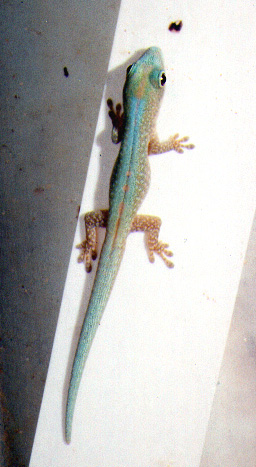- Robert Mertens' day gecko
Taxobox
name = Robert Merten's day gecko

regnum =Animal ia
phylum = Chordata
classis = Reptilia
ordo =Squamata
familia =Gekkonidae
subfamilia =Gekkoninae
genus = "Phelsuma "
species = "P. robertmertensi"
binomial = "Phelsuma robertmertensi"
binomial_authority = Meier, 1980Robert Mertens' day gecko ("Phelsuma robertmertensi" Meier, 1980) is diurnal
species ofgecko s. It lives on theComoros and typically inhabits banana trees. Robert Merten's day gecko feeds on insects and nectar. It is named after Germanherpetologist Robert Mertens .Description
This lizard species is one of the smallest of its genus. It can reach a total length of about 11 cm. The body colour can be dark green or bluish green. From the head to the tail extends an orange mid dorsal stripe. The sides of the neck as well as the flanks are greyish brown.
Distribution
This species inhabits only a small area on the island
Mayotte (Comoros ).Habitat
"Phelsuma robetmertensi" is often found on banana trees and in abandoned vanilla orchid plantations.
Diet
These day geckos feed on various insects and other invertebrates. They also like to lick soft, sweet fruit, pollen and nectar.
Reproduction
At a temperature of 28°C, the young will hatch after approximately 49–53 days. The juveniles measure 19–22 mm.
Care and maintenance in captivity
These animals should be housed in pairs and need a well planted terrarium. The temperature should be between 25 and 28°C. The humidity should be maintained between 75 and 100%. In captivity, these animals can be fed with crickets, wax moth larvae, fruit flies, mealworms and houseflies.
References
#Henkel, F.-W. and W. Schmidt (1995) "Amphibien und Reptilien Madagaskars, der Maskarenen, Seychellen und Komoren". Ulmer Stuttgart. ISBN 3-8001-7323-9
#McKeown, Sean (1993) "The general care and maintenance of day geckos". Advanced Vivarium Systems, Lakeside CA.
Wikimedia Foundation. 2010.
